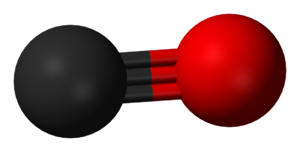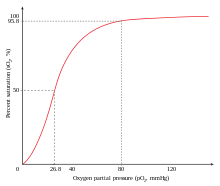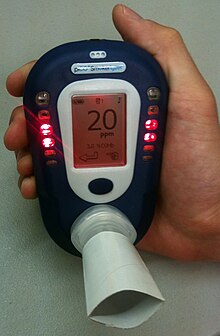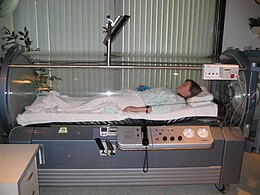Nitric oxide (nitrogen monoxide) is a molecule and chemical compound with chemical formula of NO. In mammals including humans, nitric oxide is a signaling molecule involved in many physiological and pathological processes. It is a powerful vasodilator with a half-life of a few seconds in the blood. Standard pharmaceuticals such as nitroglycerine and amyl nitrite are precursors to nitric oxide. Low levels of nitric oxide production are typically due to ischemic damage in the liver.
As a consequence of its importance in neuroscience, physiology, and immunology, nitric oxide was proclaimed "Molecule of the Year" in 1992. Research into its function led to the 1998 Nobel Prize for elucidating the role of nitric oxide as a cardiovascular signalling molecule.
Sources of NO
NO biosynthesis
Platelet-derived factors, shear stress, acetylcholine, and cytokines stimulate the production of NO by endothelial nitric oxide synthase (eNOS). eNOS synthesizes NO from the terminal guanidine-nitrogen of L-arginine and oxygen and yields citrulline as a byproduct. NO production by eNOS is dependent on calcium-calmodulin and other cofactors.
Nitric oxide synthases (NOSs) synthesize the metastable free radical nitric oxide (NO). Three isoforms
are known for the NOS enzyme: endothelial (eNOS), neuronal (nNOS), and
inducible (iNOS) - each with separate functions. The neuronal enzyme
(NOS-1) and the endothelial isoform (NOS-3) are calcium-dependent and
produce low levels of this gas as a cell signaling molecule. The
inducible isoform (NOS-2) is calcium-independent and produces large
amounts of gas that can be cytotoxic. NOS oxidizes the guanidine group
of L-arginine in a process that consumes five electrons and results in
the formation of NO with stoichiometric formation of L-citrulline. The
process involves the oxidation of NADPH and the reduction of molecular
oxygen. The transformation occurs at a catalytic site adjacent to a
specific binding site of L-arginine.
NO is an important regulator and mediator of numerous processes in the
nervous, immune, and cardiovascular systems. These include vascular
smooth muscle relaxation, resulting in arterial vasodilation and increasing blood flow.
NO is also a neurotransmitter and has been associated with neuronal
activity and various functions such as avoidance learning. NO also
partially mediates macrophage cytotoxicity against microbes and tumor
cells. Besides mediating normal functions, NO is implicated in
pathophysiologic states as diverse as septic shock, hypertension,
stroke, and neurodegenerative diseases.
Pathway for nitrosylation of heme-thiolate, steps in cell signalling (porphyrin is depicted as the square).
Exogenous NO (NO-delivery drugs)
Exogenous
NO sources constitute a powerful way to supplement NO when the body
cannot generate enough for normal biological functions. It should be noted that certain endogenous compounds can act as NO-donors or elicit NO-like reactions in vivo. Nitroglycerin and amyl nitrite serve as vasodilators because they are converted to nitric oxide in the body. The vasodilating antihypertensive drug minoxidil contains an ·NO moiety and may act as an NO agonist. Likewise, Sildenafil citrate, popularly known by the trade name Viagra,
stimulates erections primarily by enhancing signaling through the
nitric oxide pathway. Prominent examples are S-nitrosothiols, certain
organic nitrates, nitrosylated metal complexes, dinitrosyl iron complexes (DNIC), and even nitrite anions (NO2− ) under hypoxic conditions.
A high salt intake attenuates NO production in patients with
essential hypertension, although bioavailability remains unregulated.
Other, including dietary
Dietary
nitrate is also an important source of nitric oxide in mammals. Green,
leafy vegetables and some root vegetables (such as beetroot) have high
concentrations of nitrate.
When eaten and absorbed into the bloodstream, nitrate is concentrated
in saliva (about 10-fold) and is reduced to nitrite on the surface of
the tongue by a biofilm of commensal facultative anaerobic bacteria.
This nitrite is swallowed and reacts with acid and reducing substances
in the stomach (such as ascorbate) to produce high concentrations of
nitric oxide. The purpose of this mechanism to create NO is thought to
be both sterilization of swallowed food, to prevent food poisoning, and
to maintain gastric mucosal blood flow.
The nitrate-nitrite-nitric oxide pathway elevates nitric oxide
through the sequential reduction of dietary nitrate derived from
plant-based foods. Nitrate-rich vegetables, in particular leafy greens, such as spinach and arugula, and beetroot, have been shown to increase cardioprotective levels of nitric oxide with a corresponding reduction in blood pressure in pre-hypertensive persons.
For the body to generate nitric oxide through the
nitrate-nitrite-nitric oxide pathway, the reduction of nitrate to
nitrite (by nitrate reductase, a bacterial enzyme) occurs in the mouth, by commensal bacteria, an obligatory and necessary step. Monitoring nitric oxide status by saliva testing
detects the bioconversion of plant-derived nitrate into nitric oxide. A
rise in salivary levels is indicative of diets rich in leafy vegetables
which are often abundant in anti-hypertensive diets such as the DASH diet.
A related mechanism is thought to protect the skin from fungal
infections, where nitrate in sweat is reduced to nitrite by skin
commensal organisms and then to NO on the slightly acidic skin surface.
In alternative fashion, nitrite anions on sun-exposed skin may be
photolyzed to free nitric oxide radicals by UVA in sunlight.
This mechanism may elicit significant changes to the systemic blood
circulation in humans and be exploited for therapeutic purposes.
Immune response
A dinitrosyl iron complex (DNIC), the product from the immune responsive attack of NO on Fe-S proteins.
Nitric oxide is generated by phagocytes (monocytes, macrophages, and neutrophils) as part of the human immune response. Phagocytes are armed with inducible nitric oxide synthase (iNOS), which is activated by interferon-gamma (IFN-γ) as a single signal or by tumor necrosis factor (TNF) along with a second signal. On the other hand, transforming growth factor-beta (TGF-β) provides a strong inhibitory signal to iNOS, whereas interleukin-4
(IL-4) and IL-10 provide weak inhibitory signals. In this way, the
immune system may regulate the armamentarium of phagocytes that play a
role in inflammation and immune responses.
Nitric oxide is secreted as free radicals in an immune response and is
toxic to bacteria and intracellular parasites, including Leishmania and malaria; the mechanism for this includes DNA damage and degradation of iron sulfur centers into iron ions and iron-nitrosyl compounds.
The inducible pathway (iNOS) of nitrogen oxide synthesis in phagocytes can generate large amounts of NO that trigger apoptosis
and kill other cells. In vitro studies indicate that
phagocyte-dependent generation of NO at concentrations greater than
400-500 NM triggers apoptosis in nearby cells and that this effect may
act in a manner similar to Specialized pro-resolving mediators
to dampen and reverse inflammatory responses by neutralizing and then
speeding the clearance of pro-inflammatory cells from inflamed tissues. However, the role of ·NO
in inflammation is complex with model studies involving viral infection
suggesting that this gaseous mediator can also promote inflammation.
In response, many bacterial pathogens have evolved mechanisms for nitric oxide resistance. Because nitric oxide might serve as an inflammometer (meter of inflammation) in conditions like asthma, interest has increased in the use of exhaled nitric oxide as a breath test in diseases with airway
inflammation. Reduced levels of exhaled NO have been associated with
exposure to air pollution in cyclists and smokers, but, in general,
increased levels of exhaled NO are associated with exposure to air
pollution.
Molecular effects of NO on biological systems
In cells, two broad classes of reactions of nitric oxide involve the S-nitrosation of thiols and the nitrosylation of some metalloenzymes.
S-nitrosation of thiols
S-nitrosation involves the (reversible) conversion of thiol groups, including cysteine residues in proteins, to form S-nitrosothiols (RSNOs). S-Nitrosation is a mechanism for dynamic, post-translational regulation of most or all major classes of protein.
Nitrosylation of metal centers, especially iron
NO to a transition metal ion like iron or copper, forming metal nitrosyl complexes.
Typical cases involve the nitrosylation of heme proteins like
cytochromes, thereby disabling the normal enzymatic activity of the
enzyme. Nitrosylated ferrous iron is particularly stable. Hemoglobin is a
prominent example of a heme protein that may be modified by NO by both
direct attack by NO and, independently, via attack by S-nitrosothiols,
involving NO transfer from S to Fe.
The iron-containing proteins ribonucleotide reductase and aconitase are deactivated by NO. NO has been demonstrated to activate NF-κB in peripheral blood mononuclear cells, a transcription factor in iNOS gene expression in response to inflammation.
Guanylate cyclase
Although NO affects many metalloproteins, it does so by deactivating them.
Guanylate cyclase is a key component of the famous smooth-muscle
relaxing properties of NO. It is a heme-containing enzyme that is acted
on by NO, which binds to the heme. Cyclic-GMP activates protein kinase G, which causes reuptake of Ca2+ and the opening of calcium-activated potassium channels. The fall in concentration of Ca2+
ensures that the myosin light-chain kinase (MLCK) can no longer
phosphorylate the myosin molecule, thereby stopping the crossbridge
cycle and leading to relaxation of the smooth muscle cell.
Smooth muscles
Vasodilation
Nitric oxide dilates blood vessels, raising blood supply and lowering blood pressure. Conversely, it helps protect tissues from damage due to low blood supply. Also a neurotransmitter, nitric oxide acts in the nitrergic neurons active on smooth muscle, abundant in the gastrointestinal tract and erectile tissue. Sildenafil (Viagra) works to inhibit the enzyme phosphodiesterase PDE5, which increases the cGMP concentration by inhibiting the conversion to GMP.
Nitric oxide (NO) contributes to vessel homeostasis by inhibiting
vascular smooth muscle contraction and growth, platelet aggregation,
and leukocyte adhesion to the endothelium. Humans with atherosclerosis, diabetes, or hypertension often show impaired NO pathways.
Nitric oxide (NO) is a mediator of vasodilation
in blood vessels. It is induced by several factors, and once
synthesized by eNOS it results in phosphorylation of several proteins
that cause smooth muscle relaxation. The vasodilatory actions of nitric oxide play a key role in renal control of extracellular fluid homeostasis and is essential for the regulation of blood flow and blood pressure. NO also plays a role in erection of the penis and clitoris.
Cardiac effects
Nitric oxide also acts on cardiac muscle to decrease contractility and heart rate.
NO contributes to the regulation of cardiac contractility. Emerging
evidence suggests that coronary artery disease (CAD) is related to
defects in generation or action of NO.
Reduced levels of exhaled NO have been associated with exposure to traffic related air pollution.
Effects on plants
In plants, nitric oxide can be produced by any of four routes: (i) L-arginine-dependent nitric oxide synthase, (although the existence of animal NOS homologs in plants is debated), (ii) plasma membrane-bound nitrate reductase,
(iii) mitochondrial electron transport chain, or (iv) non-enzymatic
reactions. It is a signaling molecule, acts mainly against oxidative stress and also plays a role in plant pathogen interactions. Treating cut flowers and other plants with nitric oxide has been shown to lengthen the time before wilting.
In plants, NO also regulates some plant-pathogen interaction, promotion of the plant hypersensitive response, symbiosis (for example, with organisms in nitrogen-fixing root nodules), development of lateral and adventitious roots and root hairs, and control of stomatal opening. Nitric oxide is known to be produced by cellular organelles, including mitochondria, peroxisomes, and chloroplasts. It plays a role in antioxidant and reactive oxygen species responses.
Nitric oxide interactions have been found within signaling pathways of plant hormones such as auxin and cytokinin.
Atmospheric nitric oxide can enter the stomates of most vascular species, and can have effects ranging from leaf blemishing, to stunting of growth, to necrosis.
Effects in insects
Blood-sucking insects exploit vasodilation induced by NO to ensure their blood meal. These insects include Cimex lectularius (bed bug) and Rhodnius proxlixus (kissing bug). These insects deliver NO from its carrier nitrophorin carrier, which is in their saliva.
Effects in bacteria
While NO is typically known to kill bacteria as part of an immune response, in one case NO protects a bacterium. The bacterium Deinococcus radiodurans
can withstand extreme levels of radioactivity and other stresses. In
2009 it was reported that nitric oxide plays an important role in this
bacteria's recovery from radiation exposure: The gas is required for
division and proliferation after DNA damage has been repaired. A gene
that increases nitric oxide production after UV radiation was described,
and in the absence of this gene the bacteria were still able to repair
DNA damage, but would not grow.
Medical use
Neonatal use
Nitric oxide/oxygen blends are used in critical care to promote capillary and pulmonary dilation to treat primary pulmonary hypertension in neonatal patients and post-meconium aspiration related to birth defects. These are often a last-resort gas mixture before the use of extracorporeal membrane oxygenation
(ECMO). Nitric oxide therapy has the potential to significantly
increase the quality of life and, in some cases, save the lives of
infants at risk for pulmonary vascular disease.
Pathology
People with diabetes usually have lower levels of nitric oxide than patients without diabetes.
Diminished supply of nitric oxide can lead to vascular damage, such as
endothelial dysfunction and vascular inflammation. Vascular damage can
lead to decreased blood flow to the extremities, causing the diabetic
patient to be more likely to develop Neuropathy and non-healing ulcers, and to be at a greater risk for lower limb amputation.
Pediatric and adult use
The primary use is in the form of nitroglycerin, either pill or liquid spray forms, which, as a prodrug, is denitrated and releases the active metabolite nitric oxide (NO).
As with all supplements of nitric oxide, the response is
short-lived because, as a normally produced internal physiologic control
mechanism, increased concentrations lead to increased rates of
clearance, which is the reason that the effectiveness of sustained use
of nitroglycerin for vasodilation fades to none after hours to days.
In the United States, ongoing direct use of nitric oxide use is only approved for neonates. In the adult ICU setting, inhaled ·NO can improve hypoxemia in acute lung injury, acute respiratory distress syndrome, and severe pulmonary hypertension,
although the effects are short-lived and there are no studies
demonstrating improved clinical outcomes. It is used on an
individualized basis in ICUs as an adjunct to other definitive therapies
for reversible causes of hypoxemic respiratory distress.
Dosage and strength
Currently
in the United States, nitric oxide is a gas available in concentrations
of only 100 ppm and 800 ppm. Overdosage with inhaled nitric oxide will
be seen by elevations in methemoglobin and pulmonary toxicities associated with inspired ·NO. Elevated NO may cause acute lung injury.
Contraindications
Inhaled
nitric oxide is contraindicated in the treatment of neonates known to
be dependent on right-to-left shunting of blood. This is as the nitric
oxide decreases the pulmonary circulation's resistance by dilating
pulmonary blood vessels. The increased pulmonary return increases
pressure in the left atrium, causing closure of the foramen ovale and
reducing the blood flow through the ductus arteriosus. Closing these
shunts can kill neonates with heart malformations that rely on the
right-to-left shunting of blood.
Fatty liver disease
Nitric
oxide production is associated with nonalcoholic fatty liver disease
(NAFLD) and is essential for hepatic lipid metabolism under starvation.
Pulmonary embolism
Nitric oxide is also administered as salvage therapy in patients with acute right ventricular failure secondary to pulmonary embolism.
Pharmacology
Nitric oxide is considered an antianginal drug: It causes vasodilation,
which can help with ischemic pain, known as angina, by decreasing the
cardiac workload. By dilating (expanding) the arteries, nitric oxide
drugs lower arterial pressure and left ventricular filling pressure. Nitric oxide can contribute to reperfusion injury when an excessive amount produced during reperfusion (following a period of ischemia) reacts with superoxide to produce the damaging oxidant peroxynitrite. In contrast, inhaled nitric oxide has been shown to help survival and recovery from paraquat poisoning, which produces lung tissue-damaging superoxide and hinders NOS metabolism.
This vasodilation does not decrease the volume of blood the heart
pumps, but rather it decreases the force the heart muscle must exert to
pump the same volume of blood. Nitroglycerin pills, taken sublingually
(under the tongue), are used to prevent or treat acute chest pain. The
nitroglycerin reacts with a sulfhydryl
group (–SH) to produce nitric oxide, which eases the pain by causing
vasodilation. There is a potential role for the use of nitric oxide in
alleviating bladder contractile dysfunctions,
and recent evidence suggests that nitrates may be beneficial for
treatment of angina due to reduced myocardial oxygen consumption both by
decreasing preload and afterload and by some direct vasodilation of
coronary vessels.
Associated problems
There
are some associated complaints with utilization of nitric oxide in
neonatal patients. Some of them include dose errors associated with the
delivery system, headaches associated with environmental exposure of
nitric oxide in hospital staff, hypotension
associated with acute withdrawal of the drug, hypoxemia associated with
acute withdrawal of the drug, and pulmonary edema in patients with
CREST syndrome.
Mechanism of action
Nitric
oxide is a compound produced by many cells of the body. It relaxes
vascular smooth muscle by binding to the heme moiety of cytosolic
guanylate cyclase, activating guanylate cyclase and increasing
intracellular levels of cyclic-guanosine 3’,5’-monophosphate, which then
leads to vasodilation. When inhaled, nitric oxide dilates the pulmonary
vasculature and, because of efficient scavenging by hemoglobin, has
minimal effect on the vasculature of the entire body.
Inhaled nitric oxide appears to increase the partial pressure of arterial oxygen (PaO2)
by dilating pulmonary vessels in better-ventilated areas of the lung,
moving pulmonary blood flow away from lung segments with low
ventilation/perfusion (V/Q) ratios toward segments with normal or better
ratios.
Pharmacokinetics
Nitric
oxide is absorbed systemically after inhalation. Most of it moves
across the pulmonary capillary bed where it combines with hemoglobin
that is 60% to 100% oxygen-saturated.
Nitrate has been identified as the predominant nitric oxide
metabolite excreted in the urine, accounting for more than 70% of the nitric
oxide dose inhaled. Nitrate is cleared from the plasma by the kidney at rates approaching the rate of glomerular filtration.
Lung infection
NO is a potential therapeutic intervention in acute and chronic lung infections.









